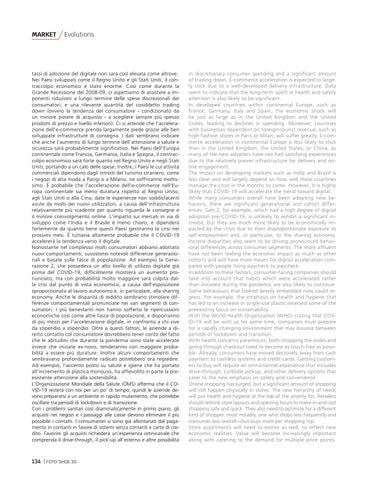MARKET
Evolutions
tassi di adozione del digitale non sarà così elevata come altrove. Nei Paesi sviluppati come il Regno Unito e gli Stati Uniti, il contraccolpo economico è stato enorme. Così come durante la Grande Recessione del 2008-09, ci aspettiamo di assistere a imponenti riduzioni a lungo termine delle spese discrezionali dei consumatori, e una rilevante quantità del cosiddetto trading down (ovvero la tendenza del consumatore - condizionato da un minore potere di acquisto - a scegliere sempre più spesso prodotti di prezzo e livello inferiori). Ci si attende che l'accelerazione dell'e-commerce prenda largamente piede grazie alle ben sviluppate infrastrutture di consegna. I dati sembrano indicare che anche l'aumento di lungo termine dell'attenzione a salute e sicurezza sarà probabilmente significativo. Nei Paesi dell'Europa continentale come Francia, Germania, Italia e Spagna, il contraccolpo economico sarà forte quanto nel Regno Unito e negli Stati Uniti, portando a un calo delle spese. Inoltre, i Paesi le cui attività commerciali dipendono dagli introiti del turismo straniero, come i negozi di alta moda a Parigi o a Milano, ne soffriranno moltissimo. È probabile che l'accelerazione dell'e-commerce nell'Europa continentale sia meno duratura rispetto al Regno Unito, agli Stati Uniti o alla Cina, date le esperienze non soddisfacenti avute da molti dei nuovi utilizzatori, a causa dell'infrastruttura relativamente più scadente per quanto riguarda le consegne e il minore coinvolgimento online. L'impatto sui mercati in via di sviluppo come l'India e il Brasile è meno chiaro, e dipenderà fortemente da quanto bene questi Paesi gestiranno la crisi nei prossimi mesi. È tuttavia altamente probabile che il COVID-19 accelererà la tendenza verso il digitale. Nonostante nel complesso molti consumatori abbiano adottato nuovi comportamenti, sussistono notevoli differenze generazionali e basate sulle fasce di popolazione. Ad esempio la Generazione Z, che possedeva un alto livello di utilizzo digitale già prima del COVID-19, difficilmente mostrerà un aumento pronunciato, ma con probabilità molto maggiore sarà colpita dalla crisi dal punto di vista economico, a causa dell'esposizione sproporzionata al lavoro autonomo e, in particolare, alla sharing economy. Anche le disparità di reddito sembrano stimolare differenze comportamentali pronunciate nei vari segmenti di consumatori. I più benestanti non hanno sofferto le ripercussioni economiche così come altre fasce di popolazione, e disporranno di più mezzi per l'accelerazione digitale, in confronto a chi vive da stipendio a stipendio. Oltre a questi fattori, le aziende a diretto contatto col consumatore dovrebbero tener conto del fatto che le abitudini che durante la pandemia sono state accelerate invece che iniziate ex-novo, tenderanno con maggiore probabilità a essere più durature. Inoltre alcuni comportamenti che sembravano profondamente radicati potrebbero ora regredire. Ad esempio, l'accento posto su salute e igiene che ha portato all'incremento di plastica monouso, ha affievolito in parte la preesistente attenzione alla sostenibilità. L'Organizzazione Mondiale della Salute (OMS) afferma che il COVID-19 resterà con noi per un po' di tempo, quindi le aziende devono prepararsi a un ambiente in rapido mutamento, che potrebbe oscillare tra periodi di lockdown e di transizione. Con i problemi sanitari così drammaticamente in primo piano, gli acquisti nei negozi e i passaggi alle casse devono eliminare il più possibile i contatti. I consumatori si sono già allontanati dal pagamento in contanti in favore di sistemi senza contanti e carte di credito. Favorire gli acquisti richiederà un'esperienza omnicanale che comprenda il drive-through, il pick-up all'esterno e altre possibilità
134 | FOTO SHOE 30
in discretionary consumer spending and a significant amount of trading down. E-commerce acceleration is expected to largely stick due to a well-developed delivery infrastructure. Data seem to indicate that the long-term uplift in health and safety attention is also likely to be significant. In developed countries within continental Europe, such as France, Germany, Italy and Spain, the economic shock will be just as large as in the United Kingdom and the United States, leading to declines in spending. Moreover, countries with businesses dependent on foreign-tourist revenue, such as high-fashion stores in Paris or Milan, will suffer greatly. E-commerce acceleration in continental Europe is less likely to stick than in the United Kingdom, the United States, or China, as many of the new adopters have not had satisfying experiences due to the relatively poorer infrastructure for delivery and online engagement. The impact on developing markets such as India and Brazil is less clear and will largely depend on how well these countries manage the crisis in the months to come. However, it is highly likely that COVID-19 will accelerate the trend toward digital. While many consumers overall have been adopting new behaviors, there are significant generational and cohort differences. Gen Z, for example, which had a high degree of digital adoption pre-COVID-19, is unlikely to exhibit a significant increase, but they are much more likely to be economically impacted by the crisis due to their disproportionate exposure to self-employment and, in particular, to the sharing economy. Income disparities also seem to be driving pronounced behavioral differences across consumer segments. The more affluent have not been feeling the economic impact as much as other cohorts and will have more means for digital acceleration compared with people living paycheck to paycheck. In addition to these factors, consumer-facing companies should take into account that habits which were accelerated rather than initiated during the pandemic are also likely to continue. Some behaviours that looked deeply embedded now could regress. For example, the emphasis on health and hygiene that has led to an increase in single-use plastic reversed some of the preexisting focus on sustainability. With the World Health Organization (WHO) stating that COVID-19 will be with us for some time, companies must prepare for a rapidly changing environment that may bounce between periods of lockdown and transition. With health concerns paramount, both shopping the aisles and going through checkout need to become as touch-free as possible. Already, consumers have moved decisively away from cash payment to cashless systems and credit cards. Getting customers to buy will require an omnichannel experience that includes drive-through, curbside pickup, and other delivery options that cater to the new emphasis on safety and convenience. Online shopping has surged, but a significant amount of shopping will still happen physically in stores. The new hierarchy of needs will put health and hygiene at the top of the priority list. Retailers should rethink store layouts and opening hours to make in-and-out shopping safe and quick. They also need to optimize for a different kind of shopper, most notably, one who shops less frequently and consumes less overall—but buys more per shopping trip. Store assortments will need to evolve as well, to reflect new economic realities. Value will become increasingly important along with catering to the demand for multiple price points.




